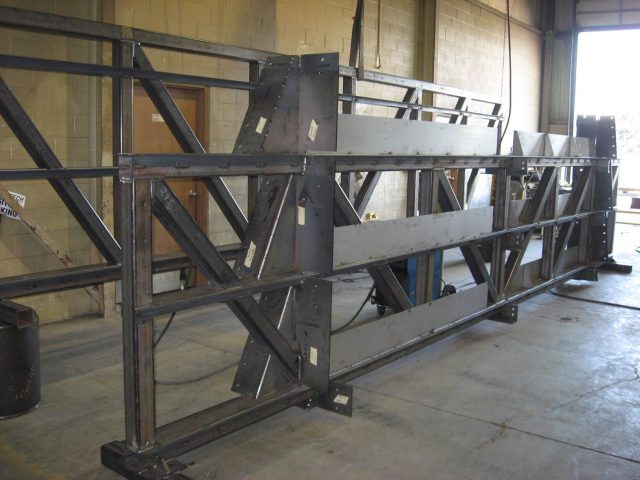In aluminum vs stainless steel fabrication work, knowing which material is better suited for an application is essential for a successful outcome of a given project. Both metals are well regarded for their versatility, durability, and corrosion resistance, among other desirable properties. Because of this, the metals are widely used by fabricators not only for numerous construction, manufacturing, aerospace, automotive, industrial, and engineering applications but also for an array of common household products and workplace tools.
Though aluminum and stainless steel are similar in appearance, for the most part, beyond the familiar silver-gray sheen, the two materials hold different properties. Thus, when considering either of the two for fabrication work, it’s important to know the benefits of aluminum as much as the advantages of stainless steel and weigh the pros and cons of each before making a choice.
Basics of Aluminum
Aluminum is a chemical and metallic element found, to a certain extent, in nearly all vegetation, animals, and rocks. With regard to the latter, the primary metallic composition of bauxite ore, a sedimentary rock mixture found in the Earth’s crust, is aluminum. The aluminum drawn from bauxite ore is, by itself, a soft, pliable, non-ferrous metal. It must be alloyed with other elements, principally, silicon, zinc, magnesium, copper, and-or manganese in order to strengthen and enhance the properties required for the fabrication of products. Aluminum is a highly malleable material, Fabricators and designers can create unique shapes and complex designs with the material.
Basics of Stainless Steel
Stainless steels are a family of corrosion-resistant steel alloys formed by adding a minimum of 10.5% chromium to iron in combination with a small percentage of carbon. As steel itself is an iron and carbon-based alloy, the chromium provides the corrosion resistance that distinguishes this family of steel from other strictly carbon-based ones and gives the steel its name. Besides its corrosion resistance, stainless steel’s mechanical properties are further enhanced with the combination of other elements such as nickel, silicon, molybdenum, titanium, niobium, and manganese. The exact composition of alloys in any grade of stainless steel depends on the properties required for a particular application. Increased corrosion resistance, high or low-temperature resistance, improved strength, weldability, or formability, are determined by a combination of alloying elements.
Aluminum vs Stainless Steel Considerations
Strength
Stainless steel is a denser, heavier, and stronger material than aluminum. Yet, though aluminum is approximately one-third the weight of steel, it has a much better strength-to-weight ratio than stainless steel. Its lightweight and strength-to-weight ratio make it ideal for many parts and components used in the automotive and aerospace industries, helping to improve fuel efficiency while increasing load capacity. On the other hand, because of its strength, stainless steel is favored by fabricators in the making of structural components as well as for design and architectural features of buildings.
Electrical and Thermal Conductivity
Comparatively, aluminum is a better conductor of electrical and thermal energies than stainless steel. Where conductivity is an important property in deciding which metal to use for a specific application, choose aluminum. Aluminum’s high electrical conductivity, combined with its lightweight and corrosion resistance, make it ideal for power lines. As a thermal conductor, aluminum is commonly used as a heat sink for devices that require rapid cooling such as radiators, LED lights, electronics, and air conditioning units.
Thermal Properties
Stainless steel has exceptional thermal properties that lend itself well to high heat applications. Aluminum will begin to soften at temperatures above 200°C, whereas stainless steel can be used at temperatures over 400°C.
Weldability
If your application requires welding, in comparison to aluminum, stainless steel is relatively far easier to weld. That, in large part, is due to aluminum’s high thermal conductivity and low melting point, which makes it a challenge to work with. Hot cracking is known to occur with aluminum when the metal begins to cool. Stainless steel’s high tensile strength is 2-3 times stronger than aluminum and can produce welds that are as strong as or stronger than the parts it joins.
Cost
The price of aluminum and steel is constantly fluctuating due to a combination of factors–supply and demand issues, fuel prices, and the accessibility of iron and bauxite ore. In general, it is the higher raw material costs associated with aluminum that make it more expensive, costing upwards of 20-30% or higher than stainless steel. Bear in mind that if aluminum is preferred, its greater strength-to-weight ratio than stainless steel means less material may be required to finish a project, thus reducing costs.
Specific Industries
Aluminum gets a bad rap for use in food applications in large part due to foil. In truth, it is significantly more likely to leach or dissolve into foods, at higher levels, under high heat, or use with acidic or spicy foods or liquids. Such reactions with food products can cause discoloration or flavor changes. Food-grade aluminum products are available and considered safe to use in the kitchen. However, aluminum products are more porous and tend to scratch and dent easily, making them harder to clean. Culinary experts and food service companies favor stainless steel due to its durability and strength. Its non-porous surface makes it ideal for applications that require sanitary conditions, such as cutlery, cookware, and kitchen equipment. Germs and bacteria cannot penetrate the material.
Deciding between aluminum and stainless steel for your fabrication project can be a challenge. It would be in your own best interests to discuss which material is better suited for the application with your fabricator. Ultimately, when it comes to aluminum vs stainless steel, which is a better application for metal fabrication will depend entirely on the desired properties needed to ensure the success of your product.
To learn more about our fabrication capabilities with both stainless steel and aluminum, please contact us at Quest Tech today!



